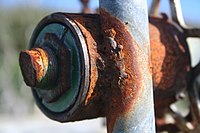
Photo from wikipedia
The design of efficient water electrolysers has received a great deal of attention in the past few decades, including significant efforts to develop hydrogenand oxygenevolving catalysts. These should exhibit as… Click to show full abstract
The design of efficient water electrolysers has received a great deal of attention in the past few decades, including significant efforts to develop hydrogenand oxygenevolving catalysts. These should exhibit as little thermodynamic penalty as possible to drive the reaction and display high long-term stability, while containing the minimum amounts of precious metals. While the state-of-the-art cathode catalysts have already achieved outstanding performances, more research is required for the oxygen-evolving counterparts. Among these, perovskite oxides are a very interesting class of anode catalysts for use in alkaline electrolytes. One design strategy consists of finding a physicochemical property that correlates with the activity that can then be tuned to find the optimum catalyst. However, this often leads to an over-simplification of a complex scenario where different reaction pathways can occur, meaning that the proposed property lacks generability and cannot be directly transferred between structurally different catalysts. Now, Emiliana Fabbri and co-workers show that for perovskite oxides, one single descriptor cannot predict the activity towards the oxygen evolution reaction (OER) but rather a combination of descriptors is required. The researchers have investigated a wide range of oxygen-deficient perovskite materials with multiple compositions, including La1−xSrxCoO3−δ (with various x fractions), LaMO3−δ (where M = Cr, Mn, Fe, Co, Ni), Ba0.5Sr0.5Co0.8Fe0.2O3−δ and PrBaCo2O6−δ. The descriptors considered are the electronic conductivity, the flat-band potential, and the amount of oxygen vacancies, which were obtained by ex situ and in situ impedance spectroscopy and neutron diffraction, respectively. The single descriptors provide a qualitative estimation of the catalytic activity, although clear outliers are found in all three. On the other hand, the researchers conclude that for a perovskite oxide to be highly active for water oxidation it has to exhibit high electronic conductivity, a high amount of oxygen vacancies and a low flatband potential.
Journal Title: Nature Catalysis
Year Published: 2018
Link to full text (if available)
Share on Social Media: Sign Up to like & get
recommendations!